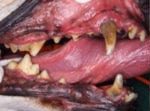Veterinary Services
Pet Dentistry
Learn more about our pet dentistry services below.
Pet Dentistry
in East Longmeadow, MA


Periodontal disease is the most common illness in dogs and cats over three years of age. Bacteria in dental plaque irritate the gum tissue, leading to infection and loss of bone surrounding the teeth.
“Bad breath” is the first sign owners often notice at home. Inflamed gums are painful, but cats and dogs are very stoic and will not show dental pain. Meanwhile, bacteria below the gum line can enter the bloodstream, and studies have proven that pets with severe periodontal disease sustain microscopic damage to kidneys, liver, and heart muscle.
Prevention is the key to management of periodontal disease: daily oral hygiene at home combined with periodic professional cleaning, and, when necessary, extraction of diseased teeth will keep your cat or dog’s mouth clean and healthy.
At East Longmeadow Animal Hospital, we are trained and equipped to provide the best dental care to your pet. A complete oral health assessment is begun in the office as part of a physical exam. Digital dental X-rays under general anesthesia are an important part of this process, allowing fast and accurate evaluation of disease below the gum line. Teeth are ultrasonically scaled both above and below the gum line, followed by polishing. The goal is to protect and save healthy teeth, and when necessary remove diseased, painful teeth. In cats, tooth resorption causes painful teeth that must be extracted for comfort. Your pet will have local nerve blocks and go home with oral pain medication. Most cats and dogs are eating within 24 hours and will eat even dry food following multiple dental extractions.
How to Brush Your Pet’s Teeth
Dental disease (especially periodontal disease) is the most common disease in pet dogs and cats. It is also one of the most preventable or reducible diseases in our pets by feeding a crunchy diet, providing appropriate chew treats and toys, and daily tooth brushing.
- The first step is to start with a clean, healthy mouth, such as with a young pet with healthy new teeth and gums or after your pet had had a professional dental cleaning.
- You will need a soft-bristled toothbrush and veterinary toothpaste. Human toothpaste and baking soda may cause problems with dogs and cats. Veterinary toothpaste has flavors that are appealing to dogs and cats. Anything other than a bristled toothbrush will not get below the gum line (the most important area to brush).
- There are several important facts about our pets’ mouths that tell us when, where, and how to brush. Periodontal disease in dogs and cats usually affects the upper back teeth first and worst. Plaque builds up on the tooth surface daily, especially just under the gum line. It takes less than 36 hours for this plaque to become mineralized and harden into “tartar” (calculus) that cannot be removed with a brush. Because of this progression, brushing should be done daily, with a brush to remove the plaque from under the gum line.
- Pick a time of day that will conveniently become part of your pet’s and your daily routine. For dogs, just before a walk and for both dogs and cats, before a daily treat can help your pet actually look forward to brushing time. Take a few days to let both of you get used to the process. Follow with praise and a walk or treat each time. Start by offering them a taste of veterinary toothpaste. The next time, let them taste the toothpaste and then run your finger along the gums of the upper teeth. Repeat the process with the toothbrush. Get the bristles of the brush along the gum from back to front, making small circles along the gum lines. It should take you less than 30 seconds to brush your pet’s teeth. Do not try to brush the entire mouth at first. If all that your pet lets you brush is the outside of the upper teeth, you are still addressing the most important area of periodontal disease prevention. If your pet eventually allows you to brush most of their teeth, so much the better.
- Even with the best tooth brushing, some dogs and cats may still need occasional professional cleaning, just like humans. By brushing your pet’s teeth daily, and curtailing the amount of periodontal disease, you may reduce the frequency and involvement of dental cleanings and provide your pet with a healthier, sweeter smile
Click here to download a guide to brushing your pet’s teeth.
